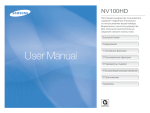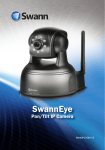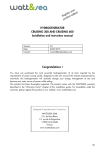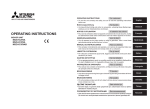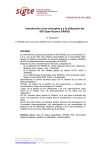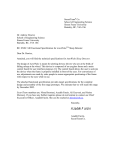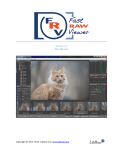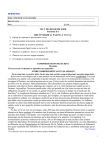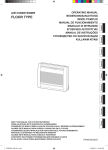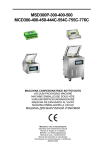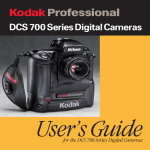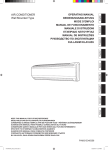Download DSLR Autofocus Modes Explained
Transcript
DSLR Autofocus Modes Explained HOME REVIEWS about us contact us http://photographylife.com/dslr-autofocus-modes-explained PHOTOGRAPHY TIPS submit content LENSES current deals GEAR GUIDE our gear SUBSCRIBE shop HOME / PHOTOGRAPHY TECHNIQUES / DSLR AUTOFOCUS MODES EXPLAINED Connect with Us jan 8 2011 DSLR Autofocus Modes Explained BY NASIM MANSUROV 135 COMMENTS 117 Like Like 61,145 people like this. Most modern digital SLR cameras are equipped with advanced autofocus systems that are often hard to understand. Whether you are shooting with an entry-level or professional DSLR, knowing how to use autofocus system effectively is essential to get sharp images. A badly-focused, blurry image can ruin a photograph and you cannot repair it in post-processing. Some professionals often end up converting Search Google Search... SEARCH their images to black and white, to hide their focusing problems. If you learn how to focus correctly, you do not have to resort to such measures and you can deliver much better results to your clients and family. Simply put, accurate focus translates to sharper images and that is something everyone is Categories Photography Techniques (81) looking for in photographs today. I know some photographers will argue with me on this, saying that Photography Tutorials (62) sometimes image blur yields a “creative” look, but it is one thing when you do it on purpose and Photography News (81) another, when you consistently mess up just because you don’t know how to focus well with your camera. Once you learn how to properly focus with your camera, you can then decide whether you want to blur something on purpose. Post Processing (83) Cameras and Lenses (445) Accessories (56) Flash Photography and Lighting (47) Tours and Travel (112) Miscellaneous (81) Composition and Art (4) Popular Posts Fuji X-E2 Review Nikon Df + 58mm f/1.4G – A Match Made In… Fastest Lens for Compact System Cameras Understanding ISO – A Beginner’s Guide BlackRapid Sport Camera Strap Review Subscribe via Email Enter your email address to subscribe to this blog and receive notifications of new posts by email. Join 6,186 other subscribers In this article, I will teach you everything I know about focus modes on modern DSLRs. Since autofocus Email Address functionality depends on what camera type and model you are using, I obviously cannot go over all SUBSCRIBE available AF modes, so I will only go through a couple of examples. Since I am a Nikon user, I will put more focus on Nikon DSLRs. Please note that this article is for more advanced DSLR users, since I go Support Us through each mode in plenty of detail. 1 of 39 12/24/13, 11:48 AM DSLR Autofocus Modes Explained http://photographylife.com/dslr-autofocus-modes-explained 1) How DSLR Autofocus Works The nice thing about digital cameras today, is that you do not have to manually focus like people used to before, back in the early film days. Digital photography is much more forgiving in this regard, because unlike film, you can see the results instantly and you can easily change your camera settings and take many exposures without worrying about film cost and replacement. Autofocus has gotten better and better over the last decade and even the cheapest entry-level DSLRs are now equipped with rather complex autofocus systems. So, how do the modern camera autofocus systems work? Let’s go over a few basics. 1.1) Active vs Passive Autofocus There are two types of AF (Autofocus) systems – Active and Passive. The “Active AF” system works by shooting infrared light on your subject, then bouncing that light back to your camera to figure out the distance between the camera and the subject. Once the camera knows what that distance is, it instructs the lens to adjust focus based on this information. The nice thing about Active AF, is that it can be used in very poorly-lit environments, where normal (passive) AF does not function. The bad thing about Active AF, is that you can only use it for stationary, non-moving subjects and it only works for close subjects within 15-20 feet. If you use a Nikon or a Canon speedlight that has an “AF Assist” function, it will use an Active AF system. On the other hand, the “Passive AF” system works very differently – instead of relying on infrared signal to find out the distance between the camera and the subject, it either uses special sensors within the camera to detect contrast from the light that goes through the lens (known as “Phase Current Promotions Detection”) or uses the camera sensor itself to detect contrast in the image (known as “Contrast Detection”). What does “detect contrast” mean? Without going into complex terminology, this simply means that it tries to look for sharpness in a particular part of an image. If it is blurry, the AF system will adjust the lens focus until sharpness/contrast is achieved. That is why the Passive AF system requires that you have enough contrast in your frame for it to be able to focus properly. When a lens starts to “hunt” for focus on single color surfaces like white walls or gradient/blurry surfaces, it happens because the camera needs objects with edges (contrast) that stand out from the background to be able to acquire focus. All mirror-less digital cameras such as point and shoot cameras, video cameras, etc. use the “Contrast Detection” AF method to obtain focus, while most modern DSLRs can use both Phase and Contrast Detection to acquire focus. Since the “Contrast Detection” AF method requires light to actually hit the sensor, DSLRs must have their mirrors raised in order for this to work, which means that contrast detection autofocus in DSLRs can only be done when the camera is in “Live View” mode. The Phase Detection AF is great for tracking moving subjects, while the Contrast Detection AF is great for stationary subjects. Contrast Detection is often more accurate than Phase Detection, especially in challenging or low-light situations. The nice thing about Contrast Detection, is that you can use any part of the image (including extreme corners) on your sensor to acquire focus, while with Phase Detection, you must use one or more of the focus points on your DSLR. The disadvantage of Contrast Detection on DSLRs at the moment, is that it is extremely slow. I’m sure manufacturers will soon catch up with this, since the speed of autofocus while capturing videos is getting more and more important on modern DSLRs. By the way, if your DSLR has an “AF Assist” lamp in front of the camera, it is not an “Active AF” beam – all it does is fire direct light at your subject like a flashlight would, so it still relies on your camera’s “Passive AF” system. Don’t worry about all this if it sounds too confusing – the technical information above is just provided to help you understand how autofocus functions. Just remember that the default autofocus behavior on 2 of 39 12/24/13, 11:48 AM DSLR Autofocus Modes Explained http://photographylife.com/dslr-autofocus-modes-explained your camera relies on the light that passes through the lens and the type of focus mode you pick (as explained further down below). 1.2) Focus Points Focus points are the little empty squares or dots that you see when you look through your viewfinder. Manufacturers often differentiate entry-level DSLRs from professional ones by implementing different types of autofocus systems. Entry-level DSLRs generally have basic AF systems with a few focus points for basic focusing needs, while pro-level DSLRs have complex, highly configurable AF systems with lots of focus points. These focus points are a part of “Phase Detection AF”, so each one of the focus points can be used by the camera AF sensors to detect contrast. The focus points are intentionally laid out in certain parts of the frame and the number of focus points, along with the layout vary not only by the manufacturer, but also by camera models. Take a look at these two types of autofocus systems with a different number of AF points and different layouts: Nikon D5000 (Left) vs D300s (Right) AF Points As you can see, Nikon D5000 has a total of 11 AF points and Nikon D300s is equipped with a total of 51 AF points – a big difference in the number of AF points. Is the number of AF points important? Of course it is – not only do you have more AF points to use while composing your shot and focusing on a particular area of an image, but also the camera AF system can use those different AF points for subject tracking (extremely useful for sports and wildlife photography). However, it is not just the sheer number of focus points that make a difference – there are also different types of focus points. 1.3) Types of AF Points Let’s talk about different types of AF points now. As I have pointed out above, the number of focus points is not the only most important factor in autofocus systems – the type of AF points is also very crucial for getting accurate results. There are two types of AF point sensors available – vertical and cross-type. Vertical sensors are one dimensional and they only detect contrast on a vertical line. Cross-type sensors are two dimensional and they can detect contrast both on vertical and horizontal lines, which makes cross-type sensors much more accurate than vertical sensors. What this means, is that the more cross-type sensors your camera has, the better and more accurate autofocus is going to be. That’s why when new cameras are announced, you will typically see something that says “x number of focus points and x number of cross-type sensors” – manufacturers proudly state the number of focus points and the number of cross-type sensors, especially when those numbers are high. For example, this is what Nikon lists under “Key Features” on the Nikon D7000: “Customizable 39 point AF System includes nine center cross-type sensors that operate with every AF NIKKOR lens so you can focus on making great images”. This means that the total number of focus points is 39, 9 of which are more accurate, cross-type sensors. Whenever you shop for a new camera, pay close attention to the total number of AF points, along with the number of cross-type sensors, because those two are important, especially if you want to shoot sports and fast-moving wildlife. 3 of 39 12/24/13, 11:48 AM DSLR Autofocus Modes Explained http://photographylife.com/dslr-autofocus-modes-explained 1.4) Other factors that impact AF performance As you can see, both the total number of focus points and their types are very important. However, those are not the only two things that are needed to get accurate results. The quality and the amount of light is another important factor that can seriously affect autofocus performance. By now, you probably already know that your camera autofocus works great when you shoot in daylight, under bright sun and starts to suffer when you move indoors to challenging light. Why is this the case? Because in low-light conditions, it is much tougher for your camera to detect contrast. Remember, Passive Autofocus completely relies on light that passes through the lens. If the quality of that light is poor, so is autofocus performance. Talking about quality of light – lens condition, its quality and maximum aperture are other important factors that affect AF performance. If you have an old lens with all kinds of physical problems such as mold, dirt, too much dust or back-focus/front-focus problems, your AF performance will surely suffer. In terms of lens maximum aperture, there is a reason why pro-level f/2.8 lenses focus much faster than f/5.6 consumer zoom lenses. All modern digital cameras focus while the lens aperture is wide open, so whenever you change the lens aperture to a higher number like f/16, the aperture actually gets changed only when you take a picture. Therefore, larger apertures are better than smaller apertures for better autofocus operation, with the exception of very fast f/1.4 prime lenses. Ideally, the lens aperture should be between f/2.0 and f/2.8 for best autofocus performance. Smaller apertures like f/5.6 mean less light passing through the lens, making autofocus operation more difficult and very large apertures like f/1.4 have a very shallow depth of field, which makes it difficult for AF systems to get accurate focus. Lastly, the overall quality and robustness of the AF system in a camera is an extremely important factor. For example, the top-of-the-line professional Canon 1D Mark III camera designed for sports and wildlife photographers was dreaded with autofocus problems when it was released and it took a while for Canon to release firmware updates to improve autofocus performance, which angered a lot of professional photographers. Many of them ended up switching to Nikon just because of this problem. The camera was packed with all kinds of autofocus features, but AF just did not work right under certain conditions. If you are looking for the best AF systems in modern DSLRs, especially if you shoot sports and wildlife, Nikon and Canon offer the most advanced and robust autofocus systems (other manufacturers are catching up pretty quickly though). 2) DSLR Focus Modes Nowadays, most DSLRs are equipped with several different focus modes for various situations. It is one thing to photograph a still subject’s portrait and another to photograph a running person or a bird in flight. When photographing still subjects, you generally acquire focus once and take a picture. If the subject moves, you reacquire focus again and take another picture. But if you have a subject that is continuously moving, you need your camera to readjust focus automatically as you take pictures. The good news is that your DSLR has the built-in functionality to handle these kinds of situations. Let’s go over these focus modes in more detail. 2.1) Single Area Focus Mode The “Single Area AF”, also known as “AF-S” in the Nikon world or “One shot AF” in the Canon world is a pretty straightforward way to acquire focus. You pick one focus point and your camera will look for contrast just in that single focus point. When you half-press the shutter or press a dedicated AF button (if you have one), the camera will snap into focus once and if your subject moves, it won’t reacquire focus even if you continue half-pressing the button. Hence, the focus remains “locked”. The Single Area AF mode often requires the camera to lock into focus before allowing you to take a picture, so if 4 of 39 12/24/13, 11:48 AM DSLR Autofocus Modes Explained http://photographylife.com/dslr-autofocus-modes-explained focus is not acquired or your subject moves, pressing the shutter will do nothing (due to focus error). Some cameras allow you to change this behavior though – on the Nikon D300s, for example, you can set the “AF-S Priority Selection” under “Autofocus” custom settings menu to “Release”, which would let you take pictures even when focus is not acquired properly. A couple of things to note about the AF-S mode – if you mount an external speedlight that has an “AF-Assist” infrared light, you will need to be in AF-S mode for it to work. The same is true for the “AF-Assist” lamp in front of your camera, it will only function in AF-S mode. 2.2) Continuous/AI Servo Focus Mode Another focus mode that is available on all modern DSLRs is called “Continuous/AF-C” (Nikon) or “AI Servo” (Canon). This mode is used for tracking moving subjects and it is a must for shooting sports, wildlife and other non-stationary subjects. The way this mode works, is it analyzes the subject movement and predicts where the subject will be, placing the focus at the predicted point. The nice thing about the Continuous mode, is that it will automatically readjust focus if you or the subject move. All you need to do is continue half-pressing the shutter button or holding the dedicated AF button (if you have one) on your camera and the autofocus system will automatically track any movement. Compared to Single Area AF, the Continuous mode is generally highly configurable (especially on high-end DSLR models) and can do complicated tasks, such as tracking subjects with a single or multiple focus points. 2.3) Single/Continuous Hybrid Mode Some cameras also have another mode called “AF-A” (Nikon) or “AI Focus AF” (Canon), which is basically a hybrid mode that automatically switches between Single/One-Shot and Continuous/AI Servo modes. The way this works, is the camera detects if the subject is stationary, in which case it automatically switches to Single focus, while if the subject moves, it will switch to Continuous focus. The default method on lower-end Nikon DSLRs is AF-A and it works quite well for most situations. Many of the higher-end/professional DSLRs do not have this mode, since it is designed for beginners. 2.4) Full-time Servo Focus Mode The new Full-time Servo AF mode, also known as “AF-F” is a brand new mode that was introduced by Nikon to the latest Nikon DSLRs like Nikon D3100 and Nikon D7000, specifically for recording video in Live View mode. This mode automatically tracks subject movement and acquires focus during video recording. While it seems to sound like a great feature, it does not work very well for fast-moving subjects and Nikon will have to work on improving this mode to make it faster and more usable. Don’t worry about this mode if you do not shoot video. I personally leave my Nikon camera on AF-C mode all the time and only switch to AF-S when the camera cannot focus in low-light situations. 2.5) Changing Focus Modes If you do not know how to change the focus mode on your camera, I recommend checking out your camera manual, because different cameras handle this differently. For example, all entry-level Nikon DSLRs require going into camera “Info” screen to change the focus mode, while higher-end DSLRs have a dedicated switch in front of the camera to toggle between different focus modes. For example, here is how you change the focus mode on Nikon D700: 5 of 39 12/24/13, 11:48 AM DSLR Autofocus Modes Explained http://photographylife.com/dslr-autofocus-modes-explained Rotating the dial to “C” will switch to Continuous/AF-C mode, rotating the dial to “S” will switch to Single Area Focus/AF-S mode and “M” is for switching to manual focus. 3) AF-Area Modes To make things more confusing, many DSLRs also have something called “AF-Area Mode”, which allows photographers to choose several options to use while operating in Single Area/Continuous modes like AF-S, AF-C, AF-A and AF-F. Many of the entry-level/semi-professional DSLRs allow you to pick a certain “AF-Area Mode” within camera menu, while pro-level DSLRs like Nikon D300s/D700/D3s/D3x have a dedicated AF-Area Mode Selector on the back of the camera. So, what do these AF-Area Modes do? Let’s go through them one by one. 3.1) Single-Point AF-Area Mode When you choose the “Single Point” (Nikon) or “Manual AF Point” (Canon) AF-Area Mode, the camera only uses one focus point that you choose in your viewfinder to acquire focus. So if you move your focus point up/down/left/right, the camera will detect contrast only on that particular focus point, using either vertical or cross-type sensors (depending on which one you have chosen). I use Single Point AF-Area Mode when photographing landscapes, architecture and other stationary subjects. 3.2) Dynamic AF-Area Mode In “Dynamic” (Nikon) or “AF Point Expansion” (Canon) AF-Area Mode, you still choose one focus point and the camera will initially acquire focus on that particular focus point. However, once focus is acquired, if your subject moves, the camera will utilize the surrounding focus points to track subject movement and keep focus on your subject. You are expected to track the subject by panning the camera along with the subject and making sure that the subject stays close to the initially selected focus point. If camera selects a surrounding/different AF point, it will not be directly visible inside the viewfinder, but will be visible after the image is taken. 6 of 39 12/24/13, 11:48 AM DSLR Autofocus Modes Explained http://photographylife.com/dslr-autofocus-modes-explained The Dynamic AF-Area Mode works great for fast-moving subjects like birds, because it is not easy to keep focus on birds in flight. Higher-end DSLRs have the ability to control the number of surrounding focus points to activate for this type of shooting. For example, the Nikon D7000 allows choosing between 9 points, 21 points and 39 points in Dynamic AF-Area Mode. So if you only wanted to track a small portion of the scene, you would pick 9 points and if you wanted to track the entire frame, you could pick all 39 points to track your subject. Lastly, many of the modern DSLRs from Nikon have a “3D-Tracking Mode”, where you initially pick the AF point and the camera will automatically activate as many focus points as needed to track subject movement. The cool thing about the 3D-Tracking mode, is that it uses a special scene-recognition system that actually reads colors and will track your subject automatically, letting you compose your shot while the subject moves. For example, if you are photographing a white bird among many black birds, the 3D-Tracking system will automatically focus on and track the white bird, even if you move your camera or if the bird moves, letting you compose your shot. If you compare 3D-Tracking to Dynamic AF-Area with a certain number of focus points selected, the 3D-Tracking method will use all available focus points on the camera to track your subject, while Dynamic AF-Area mode divides the focus points to “zones”, activating only the surrounding focus points (as many as you selected). For example, if you choose 9 focus points, subject tracking will only work within a zone of 9 total focus points that are surrounding the focus point you picked. If your subject moves away from all 9 focus points, the camera will not be able to focus on the subject anymore. In 3D-Tracking mode, the camera will continue tracking the subject (newly selected focus points will be displayed in the viewfinder), even if it significantly moves away from your initial focus point. I use the Dynamic AF-Area mode a lot when photographing birds and wildlife and typically shoot with a smaller number of focus points activated, between 9 and 21 focus points. I have some mixed feelings about the 3D-Tracking mode for photographing birds hand-held, since it does not seem to be as quick as the non-3D mode, especially when a smaller number of focus points is used. 3.3) Auto-Area AF Mode The “Auto-Area AF” (Nikon) or “Automatic AF Point Selection” (Canon) Mode is the “point-and-shoot” method of acquiring focus. Depending on what you are photographing, it will automatically pick what to focus on. It is a pretty complex mode, because it will actually recognize skin tones of a person in the frame and will automatically focus on him/her. If there are multiple people in the frame, it will focus on those that are closest to the camera. If the camera does not detect any skin tones, it will typically focus on the closest and largest object in the frame. If you shoot in Single Area/AF-S mode and select “Auto-Area AF”, the camera will actually display what focus points it will use for a second, allowing you to see and confirm the area the camera will focus on. The same thing can be done on Canon DSLRs, but it is called “Automatic AF point selection in One-Shot AF mode”. I never use this mode, because I want to control where to focus, instead of letting the camera do it for me. 7 of 39 12/24/13, 11:48 AM DSLR Autofocus Modes Explained http://photographylife.com/dslr-autofocus-modes-explained 3.4) Other Area Modes The newly-released DSLRs like Nikon D7000 have additional AF-Area Modes like “Face-priority AF”, “Wide-area AF”, “Normal-area AF” and “Subject-tracking AF” for use in video recording. These modes are probably going to be incorporated into all future Nikon DSLRs with video capability going forward. I’m not going to discuss each one of these in detail, because they are specific to certain camera models and will probably change in the future. Canon also has some AF-Area Modes like “Spot AF”, where you could fine-tune your focus inside an focus point. These extra AF-Area modes are specific to certain Canon cameras like Canon 7D. Why do you need to know how and when to use different AF-Area Modes? Because each one of them can be combined with Focus Modes! To make things easier to understand, I compiled a chart with examples for you (for Nikon DSLR Cameras): Nikon Focus Modes AF-Area Mode AF-S Mode Single-Point AF-Area Mode AF-C Mode AF-A Mode Camera acquires focus Camera focuses on the Camera detects if subject only once and on the selected single focus point is stationary or moving and selected single focus point only and will reacquire will automatically select only. focus if the subject moves. whether to use AF-S or AF-C. Only one focus point is used in either case. Dynamic AF-Area Mode Disabled, works just like You choose an initial focus Camera detects if subject Single-Point AF point and once the camera is stationary or moving and acquires focus on the will automatically select subject, it will engage the whether to use AF-S or surrounding focus points to AF-C. track subject movement. The number of surrounding focus points to use can be selected in camera menu. Dynamic AF-Area with Disabled, works just like Instead of using a Camera detects if subject Single-Point AF particular number of is stationary or moving and 3D-Tracking surrounding focus points, will automatically select the 3D-Tracking activates whether to use AF-S or all available focus points AF-C. and uses color recognition to track subjects. You pick the initial focus point and the camera will track the subject across the frame automatically, letting you Note: Not all of the above focus modes may be available on your Nikon DSLR. The new AF-F and other AF-Area video modes are not included in the above chart. 8 of 39 12/24/13, 11:48 AM DSLR Autofocus Modes Explained http://photographylife.com/dslr-autofocus-modes-explained Nikon Focus Modes AF-Area Mode AF-S Mode AF-C Mode AF-A Mode recompose the shot without losing focus on the subject. Auto-Area AF Mode Camera automatically Camera automatically Camera detects if subject picks a focus point, picks a focus point on a is stationary or moving and depending on what’s in the moving subject and will will automatically select frame. track the subject in the whether to use AF-S or frame. AF-C. Note: Not all of the above focus modes may be available on your Nikon DSLR. The new AF-F and other AF-Area video modes are not included in the above chart. 3.5) Changing AF-Area Modes To find out how to change the AF-Area Mode on your camera, again, I recommend checking out your camera manual. If you have an entry-level Nikon DSLR, you can select an AF-Area through the “Shooting Menu”, while higher-end Nikon DSLRs have a dedicated switch on the back of the camera. Here is how the switch looks like on Nikon D300/D300s/D700/D3/D3s/D3x cameras: 4) Autofocus Scenarios and Examples So far you have read a lot of technical information on each focus mode and AF-area modes. Let’s now go through different scenarios and examples for you to fully understand and grasp the information above. The camera settings I show below only apply to Nikon DSLR cameras. 4.1) Scenario #1 – Photographing Outdoor Sports Which autofocus mode and AF-area mode would you choose when photographing outdoor sports like football? Let’s start with choosing the right Autofocus Mode. Obviously, using the Single Area/AF-S mode is not going to work, since you need the camera to readjust focus continuously as you half-press the shutter/AF buttons on your camera. Therefore, we must use either AF-C or AF-A modes. I would not let the camera decide how to focus and would therefore switch to AF-C mode in such situations. What about the AF-area mode? Should you use the Single-point AF-Area Mode, Dynamic AF-Area Mode or the 3D-Tracking Mode? I would personally choose the 3D-Tracking mode and let my camera deal with tracking the subjects while I compose my shots. If you find that 3D-Tracking is not working out well and it fails to track your subjects correctly, then switch to Dynamic AF-Area mode with a relatively high 9 of 39 12/24/13, 11:48 AM DSLR Autofocus Modes Explained http://photographylife.com/dslr-autofocus-modes-explained number of focus points, especially if you are close to the action. Here is a summary of settings I would use: 1. Autofocus Mode: AF-C 2. AF-Area Mode: 3D-Tracking or Dynamic AF-Area 3. Custom Settings->Dynamic AF Area: 21-points or 51-points 4. Custom Settings->AF-C Priority Selection: Release+Focus 4.2) Scenario #2 – Photographing People Outdoors When taking portraits of people that pose for you outdoors in daylight, any of the autofocus modes should work perfectly fine. If you shoot in AF-S mode, the camera will only focus once when you half-press the shutter, so just make sure that you or your subjects don’t move once you acquire focus right before taking a picture. By default, your camera should not let you fire, if focus is not properly acquired in AF-S mode. If you are shooting in AF-C mode, just make sure to acquire good focus before taking a picture. AF-A mode works great for portraits as well. When it comes to AF-Area modes, I would stick with the Single-point AF-Area Mode, since your subjects are stationary. 1. Autofocus Mode: AF-S, AF-C or AF-A 2. AF-Area Mode: Single-point AF-Area 3. Custom Settings->AF-S Priority Selection: Focus 4. Custom Settings->AF-C Priority Selection: Release+Focus It goes without saying that you should always focus on the closest eye of your subject, especially when standing close. 4.3) Scenario #3 – Photographing People Indoors Photographing people indoors can be quite challenging, especially in low-light. If the light levels indoors are poor, I would shoot in AF-S mode to make sure that my AF-Assist beam helps me when needed. If you are using a speedlight, AF-S will make your speedlight use the AF-Assist infrared beam to acquire focus. You cannot do that in AF-C mode. The AF-A mode should also work well for these types of situations, but I would still opt to use the AF-S mode instead. In terms of AF-Area modes, I would pick the Single-point AF-Area Mode and choose the center autofocus point for better accuracy when shooting in low-light situations. 1. Autofocus Mode: AF-S 2. AF-Area Mode: Single-point AF-Area 3. Custom Settings->AF-S Priority Selection: Focus 4.4) Scenario #4 – Photographing Birds in Flight Birds are extremely tough to photograph, since it is hard to predict their behavior and they are often very fast. As I have pointed out above, I would shoot in Continuous/AF-C mode and pick Dynamic AF-Area Mode with focus points between 9 and 21 (I prefer to leave focus points at 21). I have tried using 51 focus points and also tried shooting in 3D-Tracking mode, but found those to be slower and less reliable than using less focus points. I use the center focus point 99% of the time when photographing birds and only change focus points when birds are perched on something. Again, the center focus point is normally going to give you the best results. 1. Autofocus Mode: AF-C 2. AF-Area Mode: Dynamic AF-Area 3. Custom Settings->Dynamic AF Area: 9-points or 21-points 4. Custom Settings->AF-C Priority Selection: Release+Focus 10 of 39 12/24/13, 11:48 AM DSLR Autofocus Modes Explained http://photographylife.com/dslr-autofocus-modes-explained 4.5) Scenario #5 – Photographing Landscapes and Architecture For landscapes and architecture, all focus modes work fine, but I prefer to switch to AF-S mode, since there is nothing to track. In low-light situations, you will not be able to utilize the AF-Assist function on your camera, because of distance issues. So if your camera has a Live View mode, try to use that instead on a tripod and use the contrast-detect method to focus on a bright object in your scene. Otherwise, the only other option is to turn off autofocus and manually focus your lens. When taking pictures of landscapes and architecture, you have to be extremely careful about where to focus and need to understand such things as depth of field and hyperfocal distance well. You can find more information about these in my Landscape Photography Guide. In terms of AF-Area modes, you definitely want to use Single-point AF-Area Mode in order to focus precisely on a certain part of the frame. 1. Autofocus Mode: AF-S 2. AF-Area Mode: Single-point AF-Area 3. Custom Settings->AF-S Priority Selection: Focus 4.6) Scenario #6 – Photographing Large Animals/Wildlife When photographing large animals, I would shoot in Continuous/AF-C mode and use Dynamic AF-Area or 3D-Tracking modes, both of which work great. Animals are normally not as fast as birds (although they can be even faster at times), so unless you are shooting fast action, I would just pick Dynamic AF-Area with the highest number of focus points or use 3D-Tracking. 1. Autofocus Mode: AF-C 2. AF-Area Mode: Dynamic AF-Area/3D-Tracking 3. Custom Settings->Dynamic AF Area: Highest number of AF points or 3D 4. Custom Settings->AF-C Priority Selection: Release+Focus Hopefully the above scenarios will be useful for you to understand when to use which Autofocus and AF-Area modes. Now might be a good time to go back and review the chart above and see how well you can understand it. 4.7) Scenario #7 – Photographing Small Groups I frequently get asked about how to focus when photographing a small group of people. Before I talk about focus modes, let me point out a few important things here. If you are using a standard or a telephoto lens, you have to be careful about the camera to subject distance when shooting at large apertures. If you stand too close to the group and shoot at large apertures like f/1.4-f/2.8, only one or two people might be in focus while everyone else is blurred, unless everyone is located on the same plane. The solution is to either change your aperture to something smaller like f/5.6 or f/8 or to stand back/move away from the group, so that your depth of field is increased, or do both. If you want to blur the background and shoot at large apertures, your only choice is to put everyone on the same plane, parallel to your camera. Imagine how the group would be standing if they were all touching a wall with their heads – that’s how they need to stand. In terms of autofocus modes, if you are shooting in broad daylight, any of the AF modes work fine and I would pick Single-point AF-Area Mode for focusing. 1. Autofocus Mode: AF-S, AF-C or AF-A 2. AF-Area Mode: Single-point AF-Area 3. Custom Settings->AF-S Priority Selection: Focus 4. Custom Settings->AF-C Priority Selection: Release+Focus Note: As you may have noticed, I always leave my “AF-S Priority Selection” and “AF-C Priority 11 of 39 12/24/13, 11:48 AM DSLR Autofocus Modes Explained http://photographylife.com/dslr-autofocus-modes-explained Selection” to be “Focus” and “Release+Focus”, respectively. Here is why. By keeping “AF-S Priority Selection” at “Focus”, I force my camera to not let me take a picture when I do not have good focus. I do not use the AF-S mode very often, but when I do, I want to make sure that my focus stays good. As for the “AF-C Priority Selection”, the “Release+Focus” mode works great for most situations – the camera will do its best to acquire good focus, but won’t hold up or delay the shutter too much, letting me shoot when I want. I don’t see the point of using either “Release” or “Focus” in AF-C mode. “Release” won’t care if your focus is good or not (what’s the point of autofocus then?) and “Focus” won’t let you take a picture until focus is locked. If I want my focus to be that accurate, I will switch to AF-S mode instead. Just leave these two settings as shown above and forget about them. 5) Tips to improve autofocus performance in low light As I have pointed out earlier, focusing in bright, sunny environments is often quite easy and our cameras handle that pretty well. But people start having all kinds of problems when shooting in low-light conditions, especially indoors. Here are some tips for you if you have challenges shooting in low light: 1. Use the center focus point. Whether your camera is equipped with 9 or 51 focus points, you do not want to use the focus points in the corners of the frame when shooting in low-light conditions, simply because they are not going to be very functional/accurate. The center focus point is often your best bet, because it is a cross-type sensor that works better than any other focus point in your camera. But what about framing and composition if you have to focus in the center? For those situations, the solution is to move the autofocus function from your shutter release to a dedicated button on the back of the camera, then focus on your subject and recompose. Most DSLRs, including entry-level ones can do this. Professional-level DSLRs have a button called “AF-On” specifically designed for this and you can easily activate it in Custom Settings menu by going to AF-Activation and picking “AF-ON Only”. But you have to be careful when recomposing your shots after focusing, especially when shooting at shallow depths of field with a large-aperture lens. If you focus and then recompose, your focus plane will most likely change, resulting in bad focus, so keep this in mind. 2. Use the “AF-Assist” feature on your camera or speedlight. It is there for a reason – use it every time you have problems focusing in low-light. To activate it, make sure that “AF-Assist” is turned on in your camera menu and the AF-S mode is selected. 3. Look for contrast and edges. Instead of trying to focus on plain, one-colored objects, look for “contrasty” objects that stand out from the background. 4. Add some light/Turn on more lights. Sounds pretty basic, but if you are having problems focusing, what is simpler than adding a few more lights or turning more lights in the room? Lola and I were once photographing a corporate event and the ballroom was so dim, that we had a hard time getting good shots. We both switched to AF-S and were using our flashes for focusing, but high ceilings and lack of ambient light were making our images look very flat. Lola then approached an event coordinator and simply asked her to turn up the lights and our problems all went away and we came back with beautiful pictures! 5. Watch your shutter speed. It might look like bad focus, but it might actually be camera shake that causes your images to look soft. Using a lens with Vibration Reduction technology certainly helps, but still make sure to keep your shutter speed relatively high. If you have to work with slow shutter speeds, work on your hand-holding technique. 6. Use a tripod. With a tripod, you can get very accurate focus in low-light, without worrying about moving your camera. 7. Use Live View Contrast Detect. If you are using a tripod, try focusing in Live View mode using Contrast Detect. That’s how I focused on the moon during the last lunar eclipse, as described in 12 of 39 12/24/13, 11:48 AM DSLR Autofocus Modes Explained http://photographylife.com/dslr-autofocus-modes-explained my “how to photograph a lunar eclipse” article. Whenever I use a tripod, I always try to use contrast detect, because it gives me better and more accurate results. Even manually focusing is much easier in Live View mode, since you see a lot more on the larger LCD than inside the camera viewfinder. 8. Use a bright flashlight. If your camera does not have a built-in AF-Assist lamp, use a bright flashlight and ask someone to point it at your subject while you try to focus. Switch to manual focus mode once focus is acquired, then ask your helper to turn off the flashlight and take a picture without you or your subject moving. For photographing landscapes at night, a laser pointer works quite well 9. Use manual focus. Kind of goes against the title of this article, but you should still learn how to manually focus your lenses and not be afraid to do it. Sometimes manually focusing your lens is quicker than trying to use any of the autofocus methods. Many landscape, macro and architecture photographers shoot with manual focus lenses. Like Share this article: Share 117 14 Tweet 6 204 Support Photography Life! We constantly work hard on adding unique content, gear reviews and up-to-date photography news, in addition to continuously expanding the site with new sections and useful content. However, we need your continuous support to deliver the best content and allow our website to expand its reach. If you would like to help us out, please consider purchasing gear from our links to our trusted partners like B&H Photo Video and Adorama. It won't cost you anything, but it will help us pay our contributors, hosting and other expenses to run this website. In addition, if you feel like we do a good job, you can pledge one-time or monthly. We do not run any advertising at Photography Life to keep it clean for your viewing pleasure, so your support is extremely important for us to keep it that way. Please see the Support Us page for our partner links and a donation form. Also, don't forget to follow us on Facebook and Twitter! Related posts: 1. Understanding Metering and Metering Modes 2. Understanding Digital Camera Modes 3. Nikon D3100 DSLR Announcement 4. How to buy a DSLR camera – DSLR Purchase Guide 5. What is a DSLR (Digital SLR)? FILED UNDER: PHOTOGRAPHY TECHNIQUES TAGGED WITH: DSLR CAMERA, NIKON, PHOTOGRAPHY TIPS, TIPS FOR BEGINNERS About Nasim Mansurov is a professional photographer based out of Denver, Colorado. He is the author and founder of Photography Life, along with a number of other online resources. Read more about Nasim here. Comments 1) Peter 13 of 39 12/24/13, 11:48 AM DSLR Autofocus Modes Explained http://photographylife.com/dslr-autofocus-modes-explained January 13, 2011 at 6:09 am I skimmed your article, liked the way you composed it, and then printed it to study in detail with my highlighter ready to go. This is very important information that is rarely explained in an understandable and comprehensive way. Glad to you did it. Hope it is as good as it looks, and Ii suspect it will be. I’ll write again after my study of it. REPLY 6) Nasim Mansurov January 13, 2011 at 6:02 pm Thank you for your feedback Peter, hopefully the article will help you get better at focusing your camera :) REPLY 110) Faynot August 8, 2012 at 9:38 am hi! i just bought my nikon ds3100. your article is very comprehensive. thank u! REPLY 2) KSPGM January 13, 2011 at 6:27 am Hi Nasim, Thanks for another clear and concise article. A couple of things: - How do you factor in Continuous (High/Low) Speed shooting into the Dynamic Area Mode selection? i.e does the frame rate affect your choice of number of focus points or vice versa? - What are your thoughs on Nikon’s Focus/Release options? It would be very useful if these other factors could also be added to your typical shooting scenarios. Which permutations are likely to give the best results? REPLY 7) Nasim Mansurov January 13, 2011 at 6:05 pm KSPGM, I find the Continuous Low Speed to be a useless feature for my photography needs…I never use it, because all it does is slow down my camera. For wildlife photography, I select Ch, AF-C and Dynamic Area with 21 focus points and shoot at maximum fps. As for Focus/Release options, I updated the article with some info and added them to shooting scenarios :) Thank you for your feedback! REPLY 25) KSPGM January 17, 2011 at 6:22 am Thankyou for your reply Nasim. I have (like most people I guess!) been a bit confused about these options. I generally follow your advice, but I do sometimes use Focus only when shooting in AF-C mode. One other point which I forgot about last time. That is the other function which determines how long the autofocus waits before refocusing: on a D300s it is ‘CSM:a4 Focus tracking with lock-on’. What are your thoughts on this option please? REPLY 34) Nasim Mansurov February 18, 2011 at 4:49 pm 14 of 39 12/24/13, 11:48 AM DSLR Autofocus Modes Explained http://photographylife.com/dslr-autofocus-modes-explained KSPGM, sorry for a late response. I did experiment with the “Focus tracking with lock-on” feature before and found that the “Normal” setting works best for me. If I am photographing a flying bird and a tree obstructs the bird for a short period of time, I do not want the camera to refocus on the tree immediately. Therefore, I would not turn focus tracking off or set it to short. Again, it all depends on what you are photographing… REPLY 3) Bruno January 13, 2011 at 8:51 am Great article! For now, I think I don’t have more questions about AF. Thank you very much! REPLY 8) Nasim Mansurov January 13, 2011 at 6:06 pm You are most welcome Bruno! REPLY 4) Rahul January 13, 2011 at 11:16 am hi Nasim, AF area modes was one of the confusing things that I had to read the manual a few times over to understand. One thing still isn’t clear : the difference between 3D tracking and dynamic area , not in terms of focus points but focus method. The manual, as well as this article, states that 3D tracking uses color-contrast to detect subject movement. The manual does not state that dynamic area does not use color contrast, however, so I won’t jump to conclusions and take it that dynamic area will work better when subject and background are similar in colour. So aside from number of focus points used (moot in my case, since apparently dynamic area uses all 11 points on D90, there is no option like D7000 to select 9/21/39 points). REPLY 9) Nasim Mansurov January 13, 2011 at 6:10 pm Rahul, 3D tracking and Dynamic Area work very similarly in terms of total number of AF points used, but Nikon only talks about color recognition in 3D-Tracking mode. So I don’t think the 39-point Dynamic Area is the same thing as 3D-Tracking in terms of the way they acquire focus – the 3D method is a little more complex in its nature, which is why it is also slower. Otherwise, Nikon would have merged the 39-point Dynamic Area and 39-point 3D-Tracking together into a single mode on the Nikon D7000… REPLY 17) Rahul January 14, 2011 at 7:17 am Thank you Nasim. So this is one area I’ll keep in mind to dig deeper into ! REPLY 5) Peter January 13, 2011 at 11:17 am Studied it with highlighter at my finger tips. Well done. I will keep as a reference piece near my Nikon camera manual. 15 of 39 12/24/13, 11:48 AM DSLR Autofocus Modes Explained http://photographylife.com/dslr-autofocus-modes-explained REPLY 10) Nasim Mansurov January 13, 2011 at 6:12 pm Glad you found it helpful Peter! I had some grammar problems in the article and forgot to talk about the different release modes – I have just updated the article some additional information. REPLY 11) Jaime January 13, 2011 at 6:53 pm Thank you Nasim for yet another helpful article! My most common subjects are my children (ages 9, 3 and 10months). On my D700 I have been using AF-C, Dynamic-mode mostly because they are usually moving and don’t officially pose. I am satisfied with the photos- but would I get sharper results attempting to use single-point area? Also you said to focus on the eye that is closest to you- but what should your focus be if the person is looking at you straight on? Thanks so much for your help… :) Jaime REPLY 12) Nasim Mansurov January 13, 2011 at 8:37 pm Jaime, AF-C with Dynamic AF works great for kids, I wouldn’t try AF-S on them :) As far as focusing on the eyes, if a person is looking at you straight, focus on either eye. REPLY 97) Linda June 7, 2012 at 9:22 pm Hi Nasim, Thanks so much for this posting. It is so useful! I shoot my kids too. I’m wondering if I focus on their eye and they move, does that mean the camera knows this on Dynamic AF (51 points) and I would not need to “recompose” the camera? I would just press down the shutter? Thank you! REPLY 13) Hari January 13, 2011 at 11:36 pm Mansurov, Great article, thanks a lot. REPLY 35) Nasim Mansurov February 18, 2011 at 4:49 pm You are most welcome Hari! REPLY 14) Morten January 14, 2011 at 12:19 am Wow Nasim, you have done it again! Amazing and comprehensive article and one I will return to when in doubt. I am still a little puzzled by the cross type sensor if using singe point in the outer area of the total points for a specific camera. 16 of 39 12/24/13, 11:48 AM DSLR Autofocus Modes Explained http://photographylife.com/dslr-autofocus-modes-explained I guess it is almost irrelevant with my D90, because it has so few total points (yet another reason why I want to upgrade…he he). But from what I understand out of your article, I should not be using the outer points to single point focus? Br, /Morten Your friend from Denmark REPLY 36) Nasim Mansurov February 18, 2011 at 4:51 pm Thank you Morten! No, you can certainly use the outer points, but since they are not cross-type sensors, they are not going to be as accurate. When you shoot in low-light situations, if AF does not reliably work, then simply switch to the center focus point and you should get much better results. Sorry for a late response!!! REPLY 15) moi January 14, 2011 at 2:15 am Long story. ;) Maybe published in parts will be useful? ;) REPLY 37) Nasim Mansurov February 18, 2011 at 4:52 pm Moi, I don’t like publishing stuff in parts :) REPLY 42) moi February 18, 2011 at 8:34 pm Longtime reply… :) REPLY 16) Craig Ward January 14, 2011 at 3:35 am Thank you Nasim,you have covered this often confusing area well,thou no mention of the focus tracing lock-on settings (D300 / D3/D700) Your experience with these settings ,off ,short , normal , long , in AF-C dynamic for sports situations /scenarios. Cheers Craig Frankston , Australia REPLY 38) Nasim Mansurov February 18, 2011 at 4:55 pm You are most welcome Craig! The focus tracking feature is only available on the pro-level Nikon bodies, but I will certainly add some info about that to the article. In short, I find that “Normal” works best in most situations for me. Turning focus tracking off will result in constant refocusing, which is not good when I track a subject like a flying bird. If another bird happens to fly in front of me or another object pops up in the frame, I do not want the camera to reacquire focus on the object – I want to track the bird. There are only few cases where turning focus tracking off works well. REPLY 17 of 39 12/24/13, 11:48 AM DSLR Autofocus Modes Explained http://photographylife.com/dslr-autofocus-modes-explained 18) Pradeep January 14, 2011 at 7:45 am Nasim, Thanks for another great article. I’ve been searching for a good reference material in AF modes since a long time. I have a query regarding the AF priority modes. I’m not able to find any “Release+Focus” option for AF-C priority in Nikon D7000. Can you confirm if the D7000′s “Release” priority is same as “Release+Focus” other Nikon Pro cameras? REPLY 26) KSPGM January 17, 2011 at 6:38 am Pradeep, This may be one of the little ‘omissions’ that Nikon have made on the D7000 in order to give the D300s a bit of an edge! On the D300s there are three choices: Focus, Release Release+Focus The ‘release+focus’ is in between the other two – but by how much Nikon do not say. But like Nasim, I have found that the ‘Release+Focus’ option is often the best compromise. ‘Focus’ will not fire till it has achieved focus and is clearly best for static subjects; ‘release’ fires away without pausing to think! I think ‘release’ is for when you just can’t aford to miss the shot – even if it is a bit blurred. That is not a problem for me as I do not make a living from photography! probably use at a press conference; ‘Release+ focus’ hesitates a bit before firing and gives the AF system just a little more chance to lock-on. For me, this option seems to give the most success for the type of shooting I do. REPLY 39) Nasim Mansurov February 18, 2011 at 4:57 pm Pradeep, KSPGM provided the answer above and it is correct – the D7000 does not have Release+Focus option in AF-C mode. Don’t worry about it too much though, since focus tracking on the D7000 seems to work fine with just “Release”. REPLY 19) Pradeep January 14, 2011 at 8:02 am Nasim, Can you explain what is the use of AF Lock (AE-L/AF-L) feature? How & when to use AF Lock? Nikon D7000 has a custom setting for this button action to AE lock only, AF lock only, AE/AF lock and many more. Can you let me know what should I set the button action to do? REPLY 18 of 39 12/24/13, 11:48 AM DSLR Autofocus Modes Explained http://photographylife.com/dslr-autofocus-modes-explained 21) Rahul January 15, 2011 at 2:01 am AF lock is used to recompose after acquiring focus, say first you frame and get focus , then recompose. In AF-C the camera may try to refocus and focus at something other than subject. To prevent this, pressing AF-lock tells the camera not to refocus when you recompose. In AF-S mode, the focus remains locked while the shutter button is half-pressed. AE-lock also locks the exposure values selected. I prefer to use AF-lock only, letting exposure vary but I can see why many would want to use both AF-L and AE-L – in a contrasty frame, the readjusted exposure may result in say a portrait with udnerexposed face to prevent a bright window from blown highlight, or vice versa overexpose the subject when the background is dark. So it depends on your lighting and composure. REPLY 40) Nasim Mansurov February 18, 2011 at 4:59 pm Pradeep, Rahul’s answer above is correct. To be honest, I almost never use the AF-lock function on any of my cameras, so don’t worry about it too much. AE-lock, on the other hand, can be useful when I photograph panoramas to lock my exposure values. REPLY 65) Kevin September 23, 2011 at 11:05 am Dear Nasim, I am D90 user. Do D90 have “Relase+focus” command??? or D90 just equip with Release and Focus? how to change the setting from Release to Focus? D90 dont have any cross-type sensor? REPLY 20) Dmitry January 14, 2011 at 3:15 pm Здравствуйте. Недавно набрёл на Ваш сайт в дебрях ссылок в комментариях на Nikonrumors и добавил в избранное. Очень много полезного материала и замечательное портфолио. Теперь частенько читаю Ваши статьи. Пишете ясно, просто и познавательно, спасибо большое! Есть непростой вопрос: как влияет стабилизатор на качество изображения? Статья Тома Хогана на эту тему заставила призадуматься — действительно ли стабилизатором желательно пользоваться как можно реже? Я иногда замечал, что при равных условиях резкость может быть меньше обычного, но опыта у меня мало, поэтому интересно, что об этом думают практикующие профессионалы. Если не сложно, просветите, пожалуйста. REPLY 43) Nasim Mansurov February 21, 2011 at 11:03 am Дмитрий, спасибо большое! Прошу прощения за столь поздний ответ. Я полностью согласен с Томом по поводу использования стабилизатора в благоприятных условиях. Не имеет смысла использовать стабилизатор, когда скорость выдержки превышает фокальную длину оптики. Например, если фотографируете на 300мм с 1/1000 секунды, стабилизатор будет только мешать, так как стабилизация изображения при такой скорости не нужна. Очень многие фотографы не понимают того, что снимать нужно не сразу, а через некоторое время (около 1 секунды) – после того, как кадр полностью стабилизирован. Я лично включаю стабилизатор только в том случае, когда скорость выдержки ниже фокальной длины оптики – все остальное время он у меня выключен. Скорость (выдержку) стараюсь контролировать через Auto ISO, Minimum Shutter Speed. 19 of 39 12/24/13, 11:48 AM DSLR Autofocus Modes Explained http://photographylife.com/dslr-autofocus-modes-explained REPLY 45) Dmitry February 21, 2011 at 11:07 am Спасибо, Насим! REPLY 22) Dennis January 15, 2011 at 5:57 am Good article, very helpful! Now I see where to utilize custom modes. Dennis REPLY 23) Simran Puri January 16, 2011 at 4:55 am Awesome article once again. Tons of useful info and very well presented. keep up the great work. - TC REPLY 24) Swarna Prasad January 17, 2011 at 4:45 am Fantastic article !! Very Clearly explained!! REPLY 27) Garland Ferreira January 18, 2011 at 1:37 am Thank you Nasim, great article!! REPLY 28) Benn January 18, 2011 at 9:09 am I was often confused with the use of metering, focus mode and focus areas in my D90, your explanation is very enlightening my understanding how to use these functions. I hope maybe someday you’ll give an explanation how to use AE-L or AF-L functions. Thank you Nasim..succes Benny REPLY 44) Nasim Mansurov February 21, 2011 at 11:05 am Benny, thank you for your feedback. I will put together something on AE-L and AF-L functions sometime soon. REPLY 29) Doru Lutai January 19, 2011 at 7:53 am Great article! I love it. REPLY 20 of 39 12/24/13, 11:48 AM DSLR Autofocus Modes Explained http://photographylife.com/dslr-autofocus-modes-explained 30) Denise January 19, 2011 at 11:01 am Nasim, I found your site through the recipe side (I’m going to try the Chicken Tabaka this weekend) and I was delighted to find some really great photography info was well. I really enjoyed the AF mode explanation, especially the different scenarios. I recently took my D300 to the National Zoo to photograph their 7 lion cubs and was a bit disappointed in my photos (as disappointed as you can be with 7 cute lion cubs as your subject). I had done some research on AF modes and it pretty much lines up w/ your Scenario 6 and the table. But your explanation was very helpful. REPLY 46) Nasim Mansurov February 21, 2011 at 11:20 am Denise, thank you for your feedback! I’m glad you found the article helpful and good luck with photographing the cubs next time :) REPLY 31) Surinder Gill January 22, 2011 at 11:09 am Dear Nasim you have skimmed/churned every bit of what we immatures are always looking for on the net and in the manuals. Thank you very much. REPLY 32) Brian January 24, 2011 at 3:06 am INCREDIBLE article! Thank you so much. REPLY 33) Chaithra February 10, 2011 at 3:06 am I am going to bookmark this REPLY 41) Noor February 18, 2011 at 8:24 pm Nasim ! This is by far the most elaborative explanations i have ever read …. thanks a million to you !! REPLY 47) Vinay February 24, 2011 at 2:06 am Thank you Nasim , Nikon should engage you to rewrite their manual. If Iam not asking for too much would you please explain the AEL and AFL feature. The manual (Nikon d 3100 ) falls short here too. Thanks Vinay REPLY 61) Nasim Mansurov August 24, 2011 at 11:05 pm Vinay, not sure if you have already seen it, but I posted a separate “Nikon AE-L AF-L button” article. 21 of 39 12/24/13, 11:48 AM DSLR Autofocus Modes Explained http://photographylife.com/dslr-autofocus-modes-explained REPLY 48) mosum April 8, 2011 at 10:51 am “But you have to be careful when recomposing your shots after focusing, especially when shooting at shallow depths of field with a large-aperture lens. If you focus and then recompose, your focus plane will most likely change, resulting in bad focus, so keep this in mind.” This is exactly what I’m experiencing after using a few fast lenses to shoot kids at close distance (hence shallow DOF). On my D300s, AF-C proves to be very helpful in these situations. However, unless I use AF-C along with 3-D Tracking (which does not work well all the time, esp. with busy background), I must first thumb-select an active focus sensor to recompose and then use that sensor to track my subjects. Personally I find these procedures very cumbersome compared with the simple focusthen-recompose technique using AF-S, which has worked so well on slow lenses for me up till now. When you said in Section 2.4 you use AF-C all the time, do you use techniques other than the two that I just described? REPLY 60) Nasim Mansurov August 24, 2011 at 11:01 pm Mosum, for your particular situation, the best bet would be to move the focus point to where your subject is, instead of focusing and then recomposing. I know it is slower and not always practical, but at least you won’t have to deal with focus errors due to change in focus plane. REPLY 49) Matteo April 9, 2011 at 2:16 pm Hallo. Thanks for the great explanations. There is just one thing i do not get: the AF-C continous servo can be used in two ways: with or without the 3D tracking; is this correct? in the second case focus will move and follow, in the first they will just spot other focus points around the main focus areas, but they won’t “track”. Is my understanding correct? I mean, i would use, let’s say, AF-C, with Dynamic AF areas mode, 9 points selected in the relative menu. But then if i choose the 3D tracking it is different purpose and focusing functioning. Kindly rectify if i am misunderstanding. Thanks so much. M. REPLY 59) Nasim Mansurov August 24, 2011 at 10:59 pm Matteo, the AF-C mode can be used with the selected number of focus points in camera menu or 3D tracking. When 3D is disabled and say 9 focus points are selected, the camera will track the subject only with the surrounding 9 focus points. So if your subject moves further away from the 9 focus points, the tracking will stop. The 3D tracking on the other hand, activates ALL focus points for tracking, so if your subject moves from one side of the frame to another, the camera will activate all focus points to keep the subject in focus. 3D tracking works differently than regular tracking – it is much more complex in nature. REPLY 50) Kartik April 10, 2011 at 11:57 pm Hi Nasim, I’m so glad i came across this website. I find your articles extremely helpful and jargonless(if that is a word)! 22 of 39 12/24/13, 11:48 AM DSLR Autofocus Modes Explained http://photographylife.com/dslr-autofocus-modes-explained I had a question for you..might sound silly..but … If you’re on a boat or a ship and you’re taking pictures of a landscape of say the mountains and the ocean with a couple of boats also in the frame, would you still use AF-S? Does the ships movement throw the focus out once you’ve pressed the shutter button half way down? REPLY 51) Rahul April 12, 2011 at 9:42 am I’d say it depends on the subject distance. Closer subjects could be blurry due to camera motion , while the focus wouldn’t be off, but your framing would be , depending on the frequency and amplitude of the oscillation : fast small boat would make framing very difficult as it would be bouncy, a cruise ship on quiet ocean would be relatively stable, unless you were doing low light/long exposures. REPLY 58) Nasim Mansurov August 24, 2011 at 10:48 pm Kartik, if the ship is moving fast and the distance between the nearest boat and you changes quickly, then it would be best to use AF-C instead of AF-S, especially if there is a delay between focusing and shooting. REPLY 52) Bina April 18, 2011 at 10:07 am Nasim, thank you, thank you, thank you! I spent hours browsing the internet for anything worth reading on this subject until I came across your article. You are very didactic and organized. I have two more questions. 1) I am new to the D700 and would like to understand how to go from single point to dynamic AF area mode with 3D without having to browse the menu in the camera. If I had previously selected in the menu (a3) that I want the 3D option, when I switch the dial at the back from single point to dynamic AF area mode (there are only three options: single point, area mode and auto) will the camera operate as the regular dynamic-AF area mode or it will operate as 3D? One other question: 2) There is something bothering me very much. At first, I had a5 to shutter/af-on, which should allow me to focus and lock the focus by pressing the shutter half way and then recomposing. But when I move the camera in such a way that my focus point ends up over an object in a different plane of focus, I hear clunk sounds in the camera (trying to refocus) and the camera will not hold the focus at my original point (my settings are single point AF-C). For instance, I am shooting a person in front of a background. I lock the focus by pressing the shutter half way and recompose, and at that point my center point of focus in hitting the background. I end up with a blurred picture. I couldn’t figure what settings were wrong. I was able to correct this problem by assigning the AF-on button to lock the focus (a5: AF-on only). Now I am able to lock the focus, recompose and then press the shutter to take the picture. It is ok with stationary subjects. But what happens next? Suppose I want to take a picture of a kid running towards the camera, and I don’t want him centered, of course). All I have to do then is to switch from single point to dynamic-AF area mode, lock the focus on my subject with the AF-on only button, and the camera will track the moving subject, or I need to revert to the shutter/af-on setting again? Is my line of thought correct? What am I missing? Thanks so much for sharing your knowledge and for having the patience to respond to each and every question posed to you! Very generous. Sabina REPLY 57) Nasim Mansurov August 24, 2011 at 10:47 pm You are most welcome Bina! That’s an excellent question. You go from Single Point to 3D Dynamic AF Area using the switch on the back of the camera – you just need to permanently set 51-Area 3D under “Dynamic AF Area” custom setting menu. If you need to switch to regular non-3D mode though, you will have to revisit the camera menu. So the only thing the menu controls, is how many focus points should be activated and if 3D should be enabled or not (last 23 of 39 12/24/13, 11:48 AM DSLR Autofocus Modes Explained http://photographylife.com/dslr-autofocus-modes-explained setting) – the actual single/dynamic/area drive is done through the back of the camera. As for your second question, you need to either turn on AF-ON permanently, so that focus is only activated when you press the button (and not on half-pressing the shutter), or you need to switch to AF-S mode so that autofocus is only activated once. Now if you are photographing a running child and you do not want him/her centered, then your best bet is to switch to AF-C, then move your focus point to where you want the child in your frame to be. If you keep the focus point in the center, you will not be able to focus and recompose quick enough. In this case, it should not matter if your autofocus is set to AF-ON only or on the shutter. Sometimes it is easier to keep the autofocus on the shutter for fast-moving subjects. Hope this helps… REPLY 53) Rogério August 15, 2011 at 10:09 am Thanks for the excellent explanation. I always have doubts about what focus mode to use. The photos in my D7000 are often blurred. To improve this, the best setting in most parts of the situation would be AF-C at 21 points? I almost always use AF-S. Thanks so much. REPLY 56) Nasim Mansurov August 24, 2011 at 10:30 pm Rogerio, blurry images typically happen because of slow shutter speed. Try increasing camera ISO to get faster shutter speeds. As for the AF mode, I would leave it at AF-A… REPLY 54) Martine August 21, 2011 at 4:51 am Hi Nasim I find the articles on your site very interesting. However I’m stuck with the auto focus point. I have a D40 and when set on automatic the focuspoint is well centered ( the red spot in the middle lights on when I half press the shutter) When I switch to Apperture the auto focus point moves to the right instead of to the center, this is very inconvenient aspecialy when taking macro pictures. How can I change this so the auto focus point says in the centre? I use AF area single field; AF-S and AE/AF lock I went through my manual but can’t find it. Thanks for helping me with this Martine Belgium REPLY 55) Nasim Mansurov August 24, 2011 at 10:28 pm Martine, you can move the focus point by pressing the arrow buttons on the back of the camera. If you cannot move the focus point, your AF Area mode is probably set to something funky. Go to Custom Settings menu, then go to AF Area Mode, then pick Single Area. Then, you should be able to move the focus point. If nothing works, try resetting your camera settings and see if you can move the focus point. REPLY 63) Martine August 25, 2011 at 11:20 am Nassim, your my hero :))) Such a simple trick and I couldn’t figure it out. Now I can really start experimenting with my new macro lens (AF-S Micro nikkor 105mm) I already made some pics this weekend but with the focuspoint out of center it was very hard. 24 of 39 12/24/13, 11:48 AM DSLR Autofocus Modes Explained http://photographylife.com/dslr-autofocus-modes-explained Thanks a lot REPLY 62) Nasim Mansurov August 25, 2011 at 11:23 am Martine, glad it worked! :) REPLY 64) Mirek September 16, 2011 at 1:31 am Great article. This is the most comprehensive description of AF settings I’ve found anywhere on the internet. Just one small correction of the AF-Area mode table. For recent Nikon cameras it is not true that the camera reacquires focus in single-point AF-C mode if the subject moves. This was indeed the behavior of older cameras, like D40, D50, D200, etc. However, as of D3/D300 series there is no difference of behavior between AF-S and AF-C in single point AF mode – the focus stays on selected AF point no matter if the subject moves. REPLY 89) Troy May 18, 2012 at 5:39 pm Huh? Maybe I read your reply wrong, but AF-S single point and AF-C single point are not the same. I have d7000 and d800 and if I have the camera set on AF-C single point, the camera continues to refocus if the focal distance increases or decreases. REPLY 99) Sathish June 22, 2012 at 11:22 pm Hi Troy, This question is not very relevant to this thread but since you have been using a D7000 i thought you might be able to help me with my problem. The problem is that AUTOFOCUS mode doesnt really help me capture any picture. It never works on my newly purchased D7000 + Nikkor AF-S 35mm f1.8 G lens I have ensured that the lens foucs mode switch is set to ‘M/A’ and the focus mode selector in D7000 is set to AF. The control panels top right corner indicates ‘F–’ error. I understand from the user guide that this error can only occur with a non-cpu lens. Your inputs would be of great help to me to understand what is exactly wrong. I would have to get the cam and lens replaced soon if something is faulty. Thanks for ur time Sathish REPLY 101) Troy June 29, 2012 at 7:46 pm It sounds like something is defective, either the lense or camera. Have you called nikon support? They will help you through trouble shooting and replacement. REPLY 102) Sathish June 29, 2012 at 11:20 pm Thanks Troy. 25 of 39 12/24/13, 11:48 AM DSLR Autofocus Modes Explained http://photographylife.com/dslr-autofocus-modes-explained I had called them up and i was asked to ship the camera back to them to get the issue fixed. Instead i sent it to amazon and got a replacement. Works like a charm. REPLY 66) Peder Brun September 24, 2011 at 12:40 am HI, I own a D80. The question is regarding fast focusing. Would the internal camera focus motor be on par with the focus motor in quality lens’ such as the 70-200? Which motor is selected when I attach a lens with an internal motor. I want the fastest one to be running, can both be used at the same time or is that just wishful thinking? Many thanks for clearing this matter up. Sweep sweep! Cheers, Peder REPLY 67) Sudhanshu October 2, 2011 at 11:47 am Hi, I just bought Nioon D7000 & was going thru the manual. I was perplexed about the different AF methods explained in the manual as I was not sure which one to use when. My earlier camera D70s didn’t have such complex methods. Your article gives lot of clarity but ultimately user need to try & find his spot. However, Excellent written…& address the need of the hour… Thanks Sudhanshu REPLY 68) Nigel October 3, 2011 at 12:42 am Hi Lola and Nasim My name is Nigel way down here in New Zealand. Thank you for your wonderful guide on explaining autofocus modes. I occasionally do sports photography and shoot competitive rowing, often from a moving camera boat, using a Canon 7D with a Canon EF 70-200mm f/2.8L IS USM . I use Al Servo Focus mode, but need input on the best Area mode from the following… Single point ( centre ) Custom dynamic area (centre +4 points around) Area zone ( centre 9 points ) All zone ( 19 points ) The camera has not got 3D tracking mode. I welcome your recommendations. Thanks so much REPLY 69) Aditya October 31, 2011 at 2:56 pm Hi, Thanks for this great article. Here is my interpreted summary. Please suggest if this is fine. 1. Stationary objects (landscape, monument): AF-S focus mode; Single Point area mode; focus priority 2. Slow moving objects (a man walking): AF-C focus mode; 3D Tracking area mode; release+focus 26 of 39 12/24/13, 11:48 AM DSLR Autofocus Modes Explained http://photographylife.com/dslr-autofocus-modes-explained priority 3. Fast moving object (F1 race car): AF-C focus mode; Dynamic tracking area mode; release+focus priority 4: Dont use: AF-A focus mode and Auto area mode Also, I have a question. When you refer a focus point, do you mean the AF points that are seen through the viewfinder. When I try to focus using AF points, the camera beep anf highlights a few point where it finds contrast. Can I control which exact point(s) I want the camera to find focus on, example, I want ot focus only on the right most AF point and no where else? Thanks for your help on this. Aditya. REPLY 70) Umesh December 14, 2011 at 1:30 am Hello Nasim, I’ve been struggling to understand these auto focus mode quite a while and find this article very interesting. Thanks for detailed explanation. May be a basic question, would appreciate if you could help me understand. I have D5000, there are 11 foucs points as you know. When I set it to AF-S mode, does it mean that I have to concentrate only on 1 single red focus point and foget about remaining 10 focus points(are they not point of interest in this case). Next Quetion I’m still not sure the difference between, 1. Focus mode – Single Area Focus Mode 2. AF-Area Mode – Single-Point AF-Area Mode It looks to me both are same REPLY 71) Ümit Alper TÜMEN December 15, 2011 at 7:05 am Dear Mr. Mansurovs Thank you very much for your detail explanation of AF area modes. But one thing still isn’t clear for me; Difference between Phase Detection and Contrast Detection. I would like to learn technical detail. Can you help me? Best Regards, REPLY 72) Eve December 21, 2011 at 11:46 pm Hello Nasim, Thank you ever so much for this article. When i bought my Nikon D7000 in May this year i was new to DSLRs, although i used film slrs in the old days and then after a long hiatus had a few P&S cameras (and an iPhone haha). As you can imagine, my learning curve was steep but i don’t regret jumping in an buying this “over my head” camera. I have learned tremendous amounts and have shot around 9000 pics – some pretty nice ones here and there. Inititially i was completely confused with the fact that there were autofocus modes, and autofocus area modes (really…couldn’t they use different terminology LOL, but i guess it make sense). THEN, weeks ago, i read your fabululous article here. Printed it off and keep it with all my “notes” Out of all the tons of stuff i have read to figure out how to focus that pesky D7000, your article was the most useful and enlightening! All the other sources always only gave parts on the story, but you have put it all together, so succinctly. The scenarios are great. I feel like i can finally venture out of single point/ single focus area now! Thanks so much. All your articles are rich with information. Appreciate it! REPLY 73) Saurabh January 2, 2012 at 2:33 am 27 of 39 12/24/13, 11:48 AM DSLR Autofocus Modes Explained http://photographylife.com/dslr-autofocus-modes-explained Its awesome site Nasim. I found your site yesterday and have been reading various tips and topics here. Though this site is very useful for all kind of photographers but i must say it is a great site to know the basics,particularly for a nikonian. I am a beginner and have been searching forums/sites for my doubts but most of the sites i came across ,were mainly created using canon terminology but this site is like a heaven for nikonian. I have not been subscribed to newsletters from your site yet but my mistake. i am going to subscribe right now. While reading the tips,i feel as if you are answering my doubts step by step. But i (and probably many more photographers) would love to see a new section here on “how to compose good photographs” mentioning some vital points for a good composition of an image. Thank you very much Nasim for sharing your knowledge with us. Keep it us. and yes a great and prosperous new years to you,your family and all the readers of the site. REPLY 74) Steve January 3, 2012 at 6:16 pm Dear Nasim, This article is the most comprehensive article about Nikon’s autofocus but yet simple to understand. What a good job you’ve done. After reading what you’ve written above,there are some questions that i hope you like to answer : 1. What is the function of AF-lock or AE-lock button in the side of Nikon’s viewfinder? how to use it properly? I think this is what you said about ‘dedicated button to autofocus in the back of camera’, right? what is the difference that I focus with that button and press the shutter half-way? 2. I use Nikon d7000 now (I bought it after read your review). I feel that 3d tracking autofocus has tendency to miss focus if I recompose my framing. Sometimes, it refocuses on object that has totally different color and shape with the previous object i focused before. Could you tell me what’s wrong with this? Thanks before for your time Nasim. I really look forward for your answer. REPLY 75) gian paolo perusini January 29, 2012 at 2:19 am in the d700, if the chosen focus point is not the center one, in-camera focus assist light does not light. i mean, if you move the focus point with the multiselector to a different point, it will behave differently. i have been a little puzzled at beginning, but now i have programmed the center button to reset focus point, and everything is ok. [Custom settin menu / Controls / Multi selector center button / Shooting mode / reset] i am not shure if this behaviour is well described in the manual (as everybody else, having owned quite a few nikon cameras i did not read the very thick d700 manual, but start using the d700 immediately with ease…). btw, the d700 + 70-200 vrII is a pure pleasure to use. i can’t imagine anything better! (maybe lighter…) for walk around, i found the tammy 28-75 absolutely awesome. incredibly light and cheap, and if you have a good sample, optically very very good! (of course the 24-70 is better, but try to walk a whole day with it..) i don’t know where you can find the time for your web site, but we all are very glad to read from you! best wishes to you and your family. REPLY 76) Barefoot Intactivist February 4, 2012 at 10:40 am Great article, best I’ve read explaining autofocus modes. I finally understand what modes to use for sports vs. indoors on my Nikon D7000 now. Thank you!! REPLY 77) Babu G S February 5, 2012 at 12:15 pm Awesome info…..sir please let me know about exposure compensation issue in dslr 28 of 39 12/24/13, 11:48 AM DSLR Autofocus Modes Explained http://photographylife.com/dslr-autofocus-modes-explained REPLY 78) Diane Nordine February 19, 2012 at 4:53 pm Thanks so much for your articles, you are so kind to spend your valuable time doing this, much appreciated. Could you explain in a D7000 how the shutter speed 1/250x works. It comes on my camera, & I can’t turn it off. Thanks again~~ REPLY 79) Alvaro February 22, 2012 at 8:24 am I consider myself as an amateur photographer, and as part of my conitnuous learning I surf the web looking for good articles like this one. My gear is a Nikon D7000 and this article fits me perfectly because I’m able to quickly identify all in my camera. For bird shooting I use my Nikor 80-400 lens and will definitely put in practice your advice. Thanks for writing such a detailed and pretty well put article, I believe it will help a lot of photographers around the world. REPLY 80) Leonardo March 1, 2012 at 5:34 am Hi, thanks for this article, it is very complete and easy to understand. I have an extra question: could you explain some of the reasons why the AF system might fail. I have read about some scenarios under which it fails, but what about when it stops working at all: is this a common problem? is it related to dirty lenses or reflector? What other mechanical factors can affect this? Thanks. REPLY 81) Bela Nagy March 26, 2012 at 2:36 am Hi Nasim, Excellent article, Nikon should pay you loads of money for this great explanation. I just recently joined the ‘Nikon D7000 owners camp’. Nikon’s user manual is really ‘dry’ is just explains what the different options do, but it does not explain which option should you choose regarding the situation. They made a fantastic camera but I feel that they do not explain it’s features in details. This is like a modern car where you can change the suspension and motor settings with one or two buttons according to the different situations (like city, sport, rain etc.) but they would not explain in which circumstances should you choose what. Anyway, I have been shooting with Nikon D50 for 6 years but I realised I have to learn the Nikon D7000. So far I made some 1000 pics, sports (mainly speedway), but half of them are not in focus. I’m sure there’s something with these settings so I’ll mess with these based on your explanation and will see if I can improve my photographic skills with the D7000. Thanks for this again. Best Regards, Bela REPLY 82) Ahsan Saeed March 30, 2012 at 8:00 am Dear Nasim, Thanks a lot for posting this amazing article i was looking for it for a long time…I am currently facing one problem that i have just purchased 50mm 1.8 G lens for my D3100 and everything worked fine except that when i take group photos with this lens i end up taking only person in focus..Please suggest what should i do take all the persons in frame focused..I will be really great full…Thanks in advance 29 of 39 12/24/13, 11:48 AM DSLR Autofocus Modes Explained http://photographylife.com/dslr-autofocus-modes-explained REPLY 83) Julie April 20, 2012 at 7:53 pm Just wanted to say thank you – really thorough article and learned a lot! REPLY 84) Kef April 29, 2012 at 12:29 pm Many thanks for this clear and comprehensive article on AF. I have a question though, about the types of AF sensors–cross and vertical. If the cross sensors are better and more accurate, why aren’t all of the sensors in the AF system of the cross-type? Are the cross sensors more expensive? Do the vertical sensors have some advantage that the cross-type sensors do not? Thanks for all of your wonderful articles–please keep them coming–they are much appreciated! REPLY 85) Khanh Dao April 29, 2012 at 5:59 pm Very thorough article about focusing for dslr. A must read for everyone wants to understand all aspects of nowaday dslr’s focusing. Thank you. It is definitely helpful. :) REPLY 86) sunil May 9, 2012 at 1:46 pm Hi Nasim, I’m a nikon shooter and have been shooting for a while now. I have read so many online blogs but none are this good. I mean one thing is to have an exceptional grip on the subject and it’s a different ballgame to be able to put it in words for everyone to understand. I’m really really glad i stumbled through yourwebsite. Really informative and to the point. I have a question on recomposing after focus lock, i’ve tried it so many times but i don’t get focus the way i like. it’s always soft. I’ve used a nikon D800 with 16-35, 70-200 or any flagship lens for that matter, i’ not able to tackle this issue. Any help is really appreciated. Thanks Sunil REPLY 87) Tom May 11, 2012 at 2:13 pm Hi Nasim, Thanks so much for posting this article. Very good explanation. Do you have any recommendations for shooting moving skiers on a snowy background. My Nikon D40X does not know where to focus and I have been losing a lot of photos. The lens goes back and forth but will not lock on the subject. Thanks Tom REPLY 88) Bob May 14, 2012 at 1:13 pm A friend forwarded this article to me, which I find to be awesome ! I most often photograph autos and aircraft, (warbirds and personal small planes ). I’m always perplexed as to which modes to chose when at an auto event, (parked), and at an air show, (stationary and flying ), about which combos to use. The distinction to me is that they are large objects and fill a high percentage of the frame. I’m usually trying to fill the frame and wrestle with th “point of focus” on 30 of 39 12/24/13, 11:48 AM DSLR Autofocus Modes Explained http://photographylife.com/dslr-autofocus-modes-explained a car with a 3/4 front view. I often used to choose a point about a third of the way into the vehicle, in the pre digital days, but now I’m trying to use the best combos for a speedy and accurate capture. I use two DX cameras, 7000 & a 5100, one with a short wide angle zoom and the other with a tele zoom. I’m choosing between a 10-24 & a 16-85 for short and 70-300 & 18-200 for long. Any help will be appreciated…….Bob REPLY 96) Bob June 1, 2012 at 9:15 am I don’t think I’ve had a reply to my question. Please shine a light on q#88…… Thanks-Bob REPLY 107) Bob July 8, 2012 at 6:38 pm Please reply to Q#88. Thanks REPLY 90) Feemy82 May 21, 2012 at 10:06 am Hi Nasim, You mentioned that using the centre focus point is best for optimum focus. But what if I am taking a portrait and my subject is on one side of the screen (using the rule of thirds)? I would obviously want to focus on the eyes right? Would this not mean choosing a fcus point which is not the centre focus point? Could you shine some light on this please. By the way, I love your website and articles, they are so helpful. Keep it up! Thanks REPLY 91) BUBAI May 21, 2012 at 12:05 pm Hi Nasim, I am a ” Wedding Photographer “, using my D3100 with it’s kit lens & SB 700 flash. Now willing to do some invest on it ( upgrading my weapons ). What should i do ? i ) Buy a D7000 with it’s kit lens (AF-S 18-105mm VR Kit Lens) after selling my D3100 with it’s kit lens ! ii) Buy a AF-S DX NIKKOR 16-85mm f/3.5-5.6G ED VR (5.3x), in exchange of 18-55 or 18-105 (kit lens of d3100 & d7000) & using it with my D3100 ! iii) Nikon 50 mm f 1.4 G with D3100 iv) Nikon AFS MICRO NIKOR 105 F/2.8 G ED VR with D3100 I hv noticed that some1 hv just purchased 50mm 1.8 G lens for his D3100 and everything worked fine except that when he takes group photos with this lens he ended up taking only person in focus..as he wanted to know how should he take all the persons in frame focused. please let me know what should i do? Purchase a new D7000 or should i purchase new Lenses with my older D3100 ? I just want to make my Photos much more better than now …. plz reply , thanks in advance …. REPLY 92) Steve May 21, 2012 at 7:26 pm Hi Bubai. Im not an expert in this but i have experiences about nikon entry level dslr. i used (some were borrowed) d40x, d60, d3000, d3100, d5000, d90 and d7000 (i use this now and planning upgrade to fx). I shoot weddings too, so from my experience if you shoot outdoor wedding you dont need advance dslr like d7000 for get the job done (im talking with your budget situation) but while 31 of 39 12/24/13, 11:48 AM DSLR Autofocus Modes Explained http://photographylife.com/dslr-autofocus-modes-explained shooting indoor when lighting could be compromise,that’s when you need advance dslr (or full frame). I usually use high ISO (up to 1600) while shooting indoor and d7000 or more advance dslr could deliver proper “clean ” image from noise in that ISO. AF in d7000 also faster and easy to use. From options that you have there I recommend you to got d7000. If you have tight budget for AF-S lens, you could use AF-D lens in d7000 and AF will still work from autofocus motor in D7000 body. D7000 with af-s 35mm 1,8 or af-s 50mm 1,8 wont let you down and give a superb results while used properly. Both are very cheap lens. Just like Nasim’s review af-s 50 1,8 is sharper than it’s pricy brother af-s 50 1,4 but you lost 1 stop and more creamy bokeh (doesnt matter for me,i use flash anyway). and finally,the best thing i could say is borrow or rent all options you have and compare it yourself. I always do that before having a new gear. i dont think micro 105 is proper lens for shooting wedding with crop censor. i had this lens. it’s DoF very shallow and could deliver every detail in subject’s face like pimples or things. Except you want to shoot candid from far away, i dont recommend 105 macro for wedding especially indoor wedding where place to move is limited. with this lens,you need to have 5m distances just to get full headshot. im using 16-85 for everyday photography,just like reviews said that 16-85 is the “sharpest” kit lens between 18-55, 18-105, and 18-200. I’ve used all these kits. Sad thing is it’s not that sharp like I want to. I sold my 18-200 to got this. the sharpness is nothing compare to fix prime or wide angle lens, it’s just sharp enough to walkaround but not in special purpose lens especially when you got paid for what you shoot. REPLY 93) Avi Singhal May 29, 2012 at 8:02 am Hi Nasim, I have a rather simple question: When tech is available for faster contrast detection(Our compact and mirror less cameras are the living proof of it), why is it that contrast detection is painfully slow in DSLR’s Live View ? This seems like a deliberate attempt to create market segmentation to me.. This question is driving me nuts. I would highly appreciate your response Thanks and Regards Avi Singhal REPLY 94) Kavan May 29, 2012 at 1:45 pm Hello, this is Kavan writing…simple question about autofocus…How does the autofocus system decide which object or subject in the scene it needs to focus on? What criterion does the AF system use to select the subject? thanks, kavan REPLY 95) Cy June 1, 2012 at 8:47 am Hi Nasim, Great article…going to print it and study it in greater detail. Quick question. I have a D3100 which has 11 Focus points. I still haven’t completely understood why that is required. Wouldn’t it be easier to just use the center focus point, aim that focus point where you want the subject to be focused, half click to focus and then re-frame the shot to however you want? 32 of 39 12/24/13, 11:48 AM DSLR Autofocus Modes Explained http://photographylife.com/dslr-autofocus-modes-explained I guess my question is when would there be a situation where a photographer “really has to” choose a focus point other than the center one? Thanks. REPLY 98) Francisco June 10, 2012 at 5:06 am Hola,Nasim no se si es tarde por que veo que las fechas de estas preguntas son de ace un año,pero no queria dejar pasar la ocasion para darle las gracias,tropece de casualidad con esta pagina y le puedo decir que e leido muchas de fotografia pero tan claras y bien explicadas no, es la mejor ,enhorabuena y gracias sus explicaciones son claras y de mucha ayuda,mis dudas si me lo permite es sobre el funcionamiento del ,lai viu,como acer para tener buen enfoque y componer gravando los videos,con D-300,S gracias y un saludo desde ESPAÑA…. REPLY 100) Wolfgang June 24, 2012 at 1:26 pm Thanks for an excellent article, Nasim. There was only one questions which I didn’t find answered. On the Nikon D800 you can set the general focuspoints to either 51 or 11. I wonder what is the better setting and why? Thanks REPLY 103) Neil Walton July 3, 2012 at 2:57 am Hi Nasim, What would you use for shooting airshows with a D7000, 300mm f2.8 and a 400mm f2.8? I would think AF-C,Dynamic, 21. But what about aperture priority or shutter priority, iso, raw or jpeg? Thanks Neil REPLY 104) Peter Clark July 3, 2012 at 12:14 pm Thanks for a very comprehensive article, so much better than the Nikon manuals on which I wore my eyes out at first. Peter REPLY 105) Richard Walliker July 4, 2012 at 11:05 am I have to be honest and just say “simply superb”. Clearly written In “real english” leaving no room for misunderstanding. I have read many specialist books, I just wish the clarity had been as good. Anyway Nasim, enough superlatives I think this piece of work is terrific. Thank you. Richard REPLY 106) George Augustine July 8, 2012 at 3:33 am Thanks a ton.I read it ones will read it again. REPLY 108) Adrian July 23, 2012 at 8:40 pm 33 of 39 12/24/13, 11:48 AM DSLR Autofocus Modes Explained http://photographylife.com/dslr-autofocus-modes-explained Great article!!! Couple of queries: 1) In the chart above it implies that if you set the AF Area mode (back of camera) to Dynamic (or if you use Dynamic with 3D tracking) the AF-S focus mode (front of camera) is disabled. Trying to get my head round this. I’m trying to work out what gets ‘disabled’ and why? As an example, if you select Dynamic Area AF Area Mode, from the chart it looks like the AF-S mode is disabled? Surely whether the camera focuses a single time or continuously is not a feature that gets disabled because of an AF Area mode you have selected? 2) Any thoughts on catwalk low-light settings I am experimenting but at the moment am coming round to: 1) Focus Mode: AF-C 2) AF Area Mode: Dynamic 3) Custom: AF-C Priority – Release 4) Custom: Dynamic Area – 21 5) Custom: AF Activation – Off (AF-ON only) 6) Custom: AE-L – Lock and Hold (if lighting is fixed and models being captured at same point on catwalk with camera on tripod using 70-200 2.8) I use this because if the model is still and posed a press of the AF-ON acts like single focus mode and the shot can be taken. If the models are moving, holding the AF-ON will have the camera track them. REPLY 109) Sara August 5, 2012 at 10:20 am This was extremely helpful! Thank you so much :) I’m going to favorite your site and come back again for sure…wonderful work you create! REPLY 111) Ahsan Saeed August 27, 2012 at 2:46 am Great Article no doubt learned alot…But I have a little confusion here..I mostly take Portraits and group photos at various lighting conditions..I have D3100 and also have SB700 and mostly use 50mm 1.8 lens..My question is in my situation where mostly subjects are static as they are posing for the camrera..Should i stay with AF-S and Single Area focus mode..And what should be my best practice when talking group pics say 4-5 people ..Should I focus the centre person’s eye ??? I do know my aperture shouldn’t be wide open to focus all people…Or is there any way where i can i have wide aperture and all people in the group in sharp focus..Thanks in advance REPLY 112) Courtney September 21, 2012 at 2:26 pm Thank you thank you thank you for this article! I read the manual for my nikon d3100 over and over again, but did not understand focusing until I found your article. This is the best article on tje subject I’ve ever read. Thanks again. REPLY 113) Tarun Vaish October 25, 2012 at 1:02 am Brilliant article Nasim! You have explained almost everything possible under the sun! Thank you so much! I tried looking for articles on your website which taught about the ‘AF-on’ button (I use NikonD3100) but couldn’t find one. Could you please write one on this topic? Or, if you have already written one, could you please provide me the link? REPLY 114) Satyendra Paul November 10, 2012 at 11:23 am 34 of 39 12/24/13, 11:48 AM DSLR Autofocus Modes Explained http://photographylife.com/dslr-autofocus-modes-explained Might sound cliched here, but i must say what an impressive piece of sharing of information on a subject which i could not fully comprehend till now. The amount of effort that goes into something like this is commendable. Thank you for posting this, Nasim. :-) REPLY 115) mike leach November 12, 2012 at 5:51 am After 40 years of photographing wildlife, my eyes are not as sharp as they once were. My images are becoming increasingly disappointing. As it’s time for a new camera, could you please tell me which manufacturer (you think) offers the most accurate and fastest autofocus system. Photo shops just praise the models they are trying to sell. I need a more balanced, honest opinion. At the moment I’m looking at maybe the Nikon D800. Thanks for this site Nasim REPLY 116) Jan November 20, 2012 at 9:39 am thank you for this article. it is the most comprehensive and easy to understand article on this topic…ever written! i love your flow chart; really helpful. when using af-c dynamic or 3d, do you keep your camera still once focus is locked or do you actually move your camera with the subject and it keeps up with the subject. i’m sure that’s a silly question, but when i was photographing my daughter running down a hill yesterday, i didn’t know if i was supposed to keep the camera still and let her run out of the frame or attempt to track her with the camera and the focus system moves with my movement. does that make sense? thanks again! REPLY 117) Jay January 11, 2013 at 12:35 am This article is very wonderful; staight to the point with great helpful tips. I’m a beginner and it already gives me confidence that I can take sharp pictures. I only have a couple of questions that I did not completely understand. I read the manual of my camera but I did not encounter such Active/Phasive Autofocus, as well as the Release+Focus. Base on my understanding, is AF-S is the only Active Autofocus? Since it uses the infrared to focus? Does the AF assist beam automatically switch off if I choose AF-C? Please elaborate/explain more about the the Release+Focus. Thank you in advance! I will continue to read more articles in this website because it is very helpful for me as a beginner. More power to you! REPLY 118) Chandru March 12, 2013 at 9:19 pm Hello Nasim, A very helpful artical. I am using the DSLR for two years without knowing it’s autofocus machanism and alway struggiling… REPLY 119) Bri March 21, 2013 at 10:23 am I spend a lot of time photographing my two year old daughter, her cousins and birthday parties. I have been asked many times to do family photos for friends, and have also been asked to photograph a friends wedding this summer….but I am racked with nerves over it, because of my hangup with focus and achieving sharp photos. I have been consistantly unhappy with how many out of focus or soft photos I have been getting. It happens so often, that I’m starting to feel like its a fluke if I manage to get a sharp one. I’ve noticed that in an effort to compensate, I have been 35 of 39 12/24/13, 11:48 AM DSLR Autofocus Modes Explained http://photographylife.com/dslr-autofocus-modes-explained taking a lot of close up photos, framing faces. These end up giving me the sharpness I am looking for, but my photos are all face. If I take a photo at a distance from my subjects (even at a short distance, enough to just capture them from head to toe) almost always their eyes are out of focus. Part of it I have discovered is my love for the effect a wide open aperature on my 50 mm has, but 99% is my lack of understanding the focusing modes in my Nikon DSLR. I’ve known this for some time now, and have researched ways to fix my hangup, and until todays random search yet again, my questions have gone unanswered!! I’ve also on many many many an occassion had my camera seem to ‘freeze’ and not take a photo. I never understood why, and cursed my camera!! I’ve even asked two of my professors where I’ve taken a few photography courses, and never had my questions answered. Your article is awesome and is just what I was looking for! You spelled it out so well, and in a way that learning and absorbing the information was effortless!! I can’t wait to go home and change my focus modes, and chase my daughter down with the camera, and to finally have an understanding of what I’m changing them to and why! Many many thanks!!! REPLY 120) Rahim May 18, 2013 at 8:35 am Hi Nasim, I’m new in the photography world and i found your articles very interesting and helpful. Thanks for sharing your knowledge. Rahim REPLY 121) Brian June 16, 2013 at 3:53 pm You did an excellent job explaining what can be a very confusing topic for some. It would be a lot less confusing if Canon were to adopt Nikon’s naming conventions. My question has to do with a statement you made in the first paragraph. I can understand how changing a photograph to B&W would hide white balance problems, but how does it hide focusing issues since all the tonality & contrast information would remain? Thanks! REPLY 122) Khurshed Marolia July 30, 2013 at 8:56 pm Hello, I am Khurshed, from Mumbai, India. I have a Nikon D7000 with the standard 18 – 105 mm lens. Is it ok to leave the lens switch to A and focus button/lever to A while the camera mode is in M (the main mode dial). Can this damage the camera, if pictures taken in this mode? Please advise. Thank you. REPLY 123) Cyrus July 31, 2013 at 6:15 am Hi Khurshed, I understand the lens switch on “A” and camera mode in “M” but can you clarify what you mean by focus button / lever to “A”. I don’t have a D7000 so I might be missing something here but if you can let me know what the focus button/lever set to “A” does I might be able to help you. Thanks. REPLY 124) Cyrus July 31, 2013 at 6:26 am I see it now…I think you were talking about the “focus mode selector” towards the bottom front of the camera. Correct? If that’s the case, I don’t see any problem. 36 of 39 12/24/13, 11:48 AM DSLR Autofocus Modes Explained http://photographylife.com/dslr-autofocus-modes-explained Your lens switch is set to “Auto Focus”. Camera Mode set to “M” simply means manual exposure and has nothing to do with focus. Since your lens switch is set to “Auto Focus” (i.e. “A”), the focus mode selector switch should also be set to “AF”. Just make sure that you have selected the appropriate AF mode. Read more: http://photographylife.com/dslr-autofocus-modes-explained#ixzz2acq9UhHb REPLY 125) Shriram August 1, 2013 at 9:12 pm Beautifully conveyed :)! Nice article! REPLY 126) Nick August 2, 2013 at 10:55 am Thanks for this article – exactly what I was after. I recently got a body with the 3D-tracking option but I never really understood what it was doing so always went AF-C for wildlife. Now I know how it works and in which situations it might be most useful, I’ll experiment with it a bit. REPLY 127) manjula August 15, 2013 at 8:15 pm Thanks your lession REPLY 128) Donnell August 22, 2013 at 9:50 pm Hi Nasim, I have been following your site for some time now and I must say your articles and reviews are spot on. Your articles take very difficulty, confusing and sometimes complex photography information and explain it in a very simplified way. Thanks for sharing your knowledge of photography. REPLY 129) MS Raju August 23, 2013 at 6:15 pm Excellent Articles Thank you so much!…….Simply Superb… REPLY 130) Jean-Paul Laberge August 28, 2013 at 4:10 pm Nasim, Your article is the best on Autofocus. You can write a clear article on a complex subject. I add your article on my Website PHOTOPRATICO : https://sites.google.com/site/photopratico /home. Thanks a lot. Jean-Paul Laberge MBA REPLY 131) Anne September 17, 2013 at 8:04 pm thanks for the great article. This was much easier to read and understand than the camera manual! 37 of 39 12/24/13, 11:48 AM DSLR Autofocus Modes Explained http://photographylife.com/dslr-autofocus-modes-explained REPLY 132) Sreejib September 26, 2013 at 10:13 pm Hi Nasim, Such a wonderful article wrote by you it’s help me lots. But, I have still little bit confusion regarding the focusing point. Mainly I am a Canon shooter & have 60D & 7D both cameras have all cross type focusing points 9 & 19 respectively. I have followed on the both cameras are capable to focus with extreme corner focus point (Left or Right) even with slow lens like f/3.5-5.6 with zoom end position. Recently I have tried my friends Nikon D300S with Nikkor 16-85mm f/3.5-5.6 ED VR . But, I am surprisingly followed that the camera is unable to focus with the extreme corner focus points at 85mm zoom position when the f number is 5.6 & at the same time with the 24-70 f/2.8 lens it’s focusing with out any hesitation. So, my question is it really necessary to put huge (51) focusing points except the 15 cross type in the middle. If it’s necessary then up to which F number the rest 36 focus points are sensitive. Thanks & regards Sreejib. REPLY 133) Sam October 25, 2013 at 3:33 am Hi Nasim, One of the most simple and informative article I ever read on Autofocus. I will make it a habit to go through your articles before taking clicks! Kudos to you!! Sam REPLY 134) Heather November 11, 2013 at 2:50 pm Hi :) I just want to say thank you thank you thank you for writing this article. I went from a point and shoot to a DSLR because I decided I really loved what I was doing and wanted more creative control. I decided on the d3200, for a beginners DSLR it had good reviews and I was afraid to go all out with a more expensive camera. Problems ensued as soon as I turned on the camera without reading the manual or getting any ideas about how it might work lol. I could not figure out for the life of me why my camera would not focus when I half pressed the shutter button. I soon discovered after much reading and playing around that I had the AF on button clicked in the menu. So the focusing finally began. After that confusion. What is with all of these dots and options for focus. I had done some messing around myself and just had a beginning grasp. I am so happy you wrote this because now I know I am going to get better photos. Please keep writing :) Thanks again Heather REPLY 135) Kathy December 18, 2013 at 10:34 am I am glad I found your site. it is excellent. I was reading the settings for group portrait 4.7. I understand it until the last two settings CUSTOM AF C and AF S, focus and release plus focus. I don’t no where to find those setting in my Nilon5000. Thanks. REPLY Leave a Comment 38 of 39 12/24/13, 11:48 AM DSLR Autofocus Modes Explained http://photographylife.com/dslr-autofocus-modes-explained Name * Email * Website POST COMMENT Notify me of follow-up comments by email. Notify me of new posts by email. COPYRIGHT © 2013 PHOTOGRAPHY LIFE RETURN TO TOP OF PAGE 39 of 39 12/24/13, 11:48 AM










































